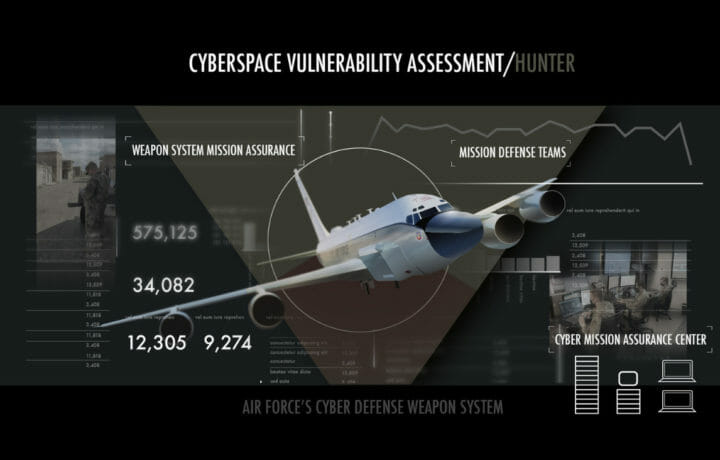Given the threat that attacks in cyberspace now pose to the safety and security of the United States, it could become another potential battle realm that requires the attention of the U.S. military. This month, the U.S. Air Force announced that the 55th Communications Squadron had recently met all objectives required by the service to be redesignated as the 55th Cyber Squadron.
As part of that redesignation, the unit will add a new Mission Defense Team to its overall capabilities while still continuing to maintain its legacy mission.
“I’m so proud of the unit and our amazing Airmen,” said Lt. Col. Christopher Wong, 55th CS commander. “We have accomplished all of this through COVID, with a huge deployment burden and the transition to Lincoln.”
For the unit’s Airmen, this redesignation also will mean that they are not only responsible for ensuring the installation’s communication infrastructure is protected, but they will also be charged with providing proactive cyber defense operators on the Air Force’s tactical edge.
“One of the major hurdles that we had to overcome was shifting our mindset from a maintenance to an operational perspective,” said 2nd Lt. Jeffrey Cruse, 55 CS Cyber Defense Flight commander. “No longer is our primary focus customer issues or general system maintenance, but instead we are thinking about ways to engage near-peer adversaries and defend our mission critical networks and infrastructure.”
Cyber Warriors
The redesignation to a cyber squadron came only after the unit met four phases outlined by the Air Force. It required the unit to maintain its current mission, declare Initial Operating Capability on its new MDT mission, implement Enterprise IT-as-a-Service (EIaaS), and having the wing commander recommend the redesignation to the unit’s major command.
By continuing its legacy mission and with the implementation of EITaaS at Offutt Air Force Base (AFB), NE in 2020, the newly redesignated 55th Cyber Squadron has had to focus its efforts on ensuring its new MDT mission met all of its IOC requirements to make the transition a reality.
“Due to some very unique circumstances here at Offutt (AFB), our squadron was in an advanced position, which enabled us to be a front running cyber squadron and MDT organization,” Wong added.
Along with meeting all of the criteria for the redesignation, the unit also underwent some internal restructuring. The 55th Cyber Squadron has consolidated all battlespace activities under the new Information Technology Support Flight, defined a distinct Operation Support Flight, and changed the name of the Cyber Protection Flight to Cyber Defense Flight.
As part of this redesignation, the unit has further integrated itself into the wing’s operations environment, and this included allowing its Airmen access to the RC-135’s ground and onboard systems for the first time ever.
“We want to employ each individual’s technical expertise and talents to get after the mission set,” Wong added.
“This will be key when we start engaging nation states as they will have to rely on those critical-thinking abilities in order to plan, execute and operate in those environments.”
The unit has been equipped with new specific cyber equipment, while it also tweaked its manning document and qualification training, as well as making adjustments to the development of unit-specific defensive tactics, techniques and procedures.
However, it would be a misunderstanding to see the new as “cyber warriors” in a true combat sense, as the unit won’t be taking on offensive capabilities in a cyber domain.
“This isn’t defining cyber as another battle realm,” said Bryson Bort, CEO of cybersecurity platform developer SCYTHE.
“It’s recognizing that mission systems are increasingly computerized and interconnected which makes them more vulnerable along with the traditional enterprise that enables the military units themselves to execute their missions through communication and coordination,” Bort told ClearanceJobs.
New Emphasis in Cyber
The 55th Cyber Squadron is far from the first unit to be assigned to the new battle space. For more than a decade, the Pentagon has put increased focus in defending American’s interests online.
“In 2010, the U.S. Department of Defense (DoD) created the US Cyber Command and added cyberspace to the sea, land, air, and space domains,” said Bill Lawrence, CISO of cybersecurity risk management firm SecurityGate.
“The transition of the USAF 55th Communications Squadron to a Cyber Squadron reflects the continuing recognition that national-level strategic assets like the RC-135 need defense of the critical networks and infrastructure required for their mission,” Lawrence told ClearanceJobs. “The organizational changes, training, and equipping that the 55th CS underwent before earning their ‘mission ready’ status also shows how much more mature the military’s approach towards cyber security has become, with well-developed processes and experienced evaluators. It is also good to see that the personnel are integrated into the operational units, for better understanding of the mission, but also exposure to real-life operations.”




